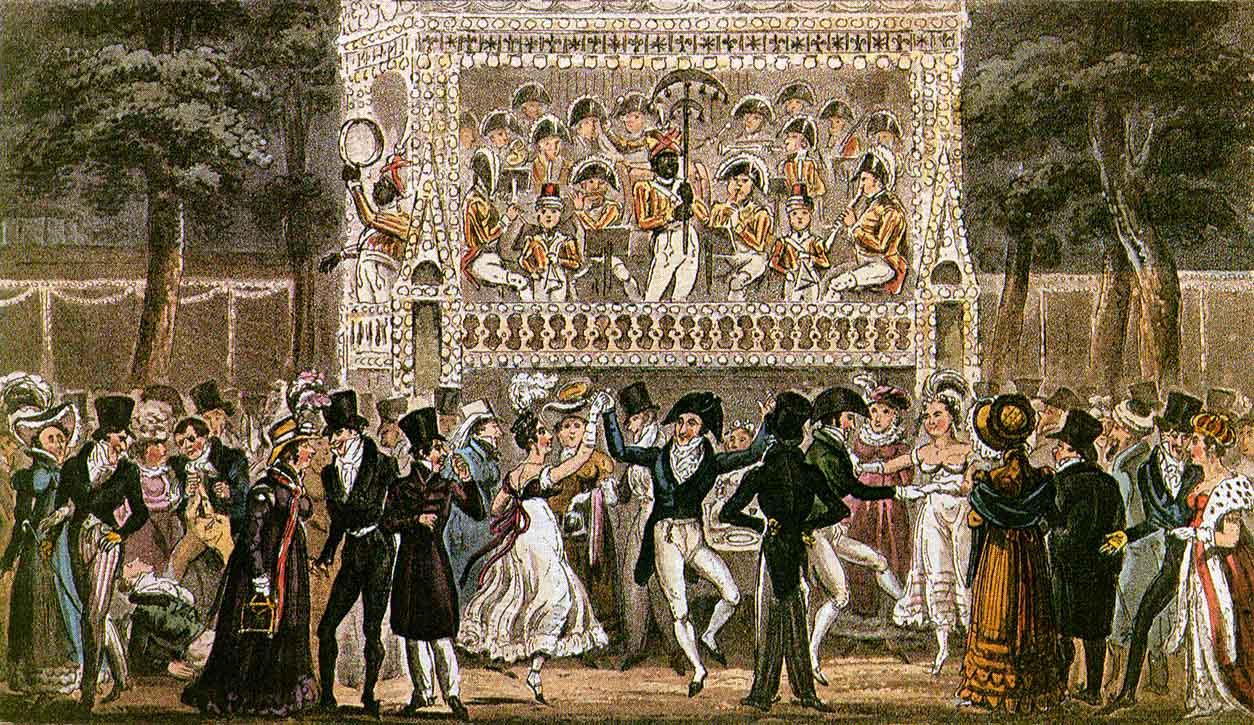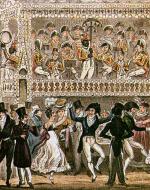Created by Abigail Smagala on Tue, 10/08/2024 - 21:33
Description:
This image is Isaac Robert Cruikshank and George Cruikshank’s “Tom, Jerry, and Logic Making the Most of an Evening at Vauxhall.” This piece depicts a formal event at the Vauxhall Gardens in London and showcases the orchestra in the center of the illustration. Separate spaces for live musicians, such as the one shown in the image, were common during the Regency Era and were also present in the ballrooms at the public assembly rooms like the Bath Assembly Rooms and Almack’s. Music for each dance was chosen by the lady leading the set.
While professional musicians were common at public assemblies and potentially at privately hosted balls, more amateur musicians and orchestras played at less formal events. The ability to play a musical instrument was expected of young women in Jane Austen’s world. Austen herself was reported to be an amateur musician; she began studying piano at the age of twenty and, at the time of her death, left behind nearly a dozen volumes of music that included pieces by Bach, Mozart, Haydn, and Handel. These more classical pieces may not have been popular at balls, as the higher energy jigs, reels, country dances, cotillions, and quadrilles were common.
Music and musical instruments were often included in Jane Austen’s novels. Austen uses music and the ability to play music as a way to incorporate and critique the idea of social class, as Gillian Dooley, Kirstine Moffat, and John Wiltshire discuss in their paper, “Music and Class in Jane Austen.” The authors highlight that a character having a musical instrument or having the ability to play served as a sign of a character’s social status. Additionally, at this time, music was beginning to become a less respected occupation, particularly for the lower classes, which the authors state allowed European professional musicians who were not a part of the British class system to become more dominant in the field.
Works Cited
Alltop, Stephen, and Josefien Stoppelenburg. "Jane Austen at the Piano." Persuasions On-Line, vol. 42, no. 1, winter 2021. Jane Austen Society of North America, jasna.org/publications-2/persuasions-online/vol-42-no-1/alltop/. Accessed 8 Oct. 2024.
Cruikshank, Issac Robert, and George Cruikshank. Tom, Jerry, and Logic Making the Most of an Evening at Vauxhall. 1821. Birmingham Museum of Art, www.artsbma.org/collection/tom-jerry-and-logic-making-the-most-of-an-eve....
D'Arcy Wood, Gillen. "Austen's Accomplishment: Music and the Modern Heroine." A Companion to Jane Austen, edited by Claudia L. Johnson and Clara Tuite, Wiley-Blackwell, 2012, pp. 366-76.
Dooley, Gillian, et al. "Music and Class in Jane Austen." Persuasions On-Line, vol. 38, no. 3, summer 2018. Jane Austen Society of North America, jasna.org/publications-2/persuasions-online/volume-38-no-3/doolley-moffat-wiltshire/. Accessed 8 Oct. 2024.
"Jane Austen and Music." Jane Austen's World, 12 July 2010, janeaustensworld.com/tag/regency-music/. Accessed 8 Oct. 2024.
Rendell, Jane. "Almack's Assembly Rooms: A Site of Sexual Pleasure." Journal of Architectural Education (1984-), vol. 55, no. 3, 2002, pp. 136-49. JSTOR, www.jstor.org/stable/1425532. Accessed 7 Oct. 2024.
Copyright:
Associated Place(s)
Part of Group:
Featured in Exhibit:
Artist:
- Isaac Robert Cruikshank and George Cruikshank


